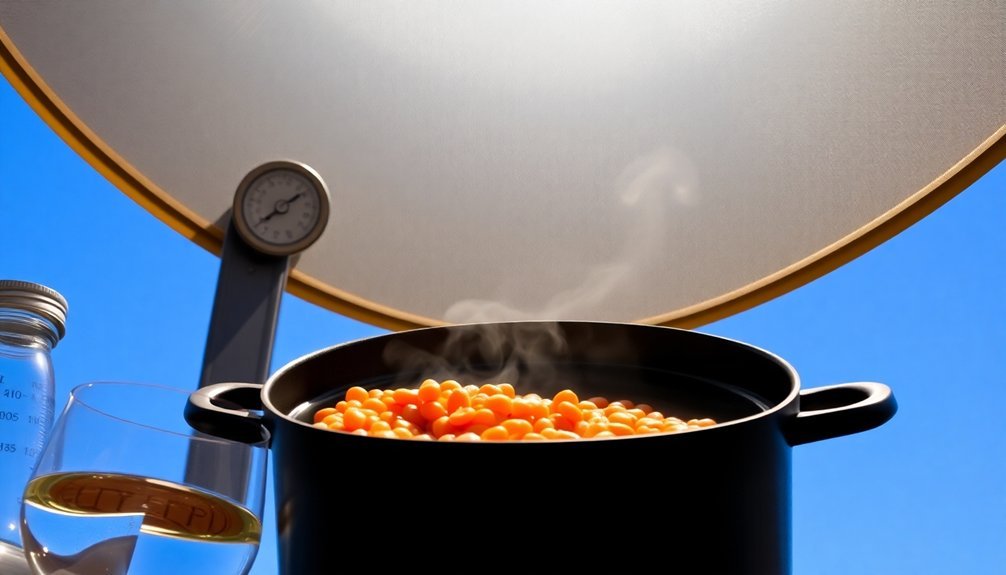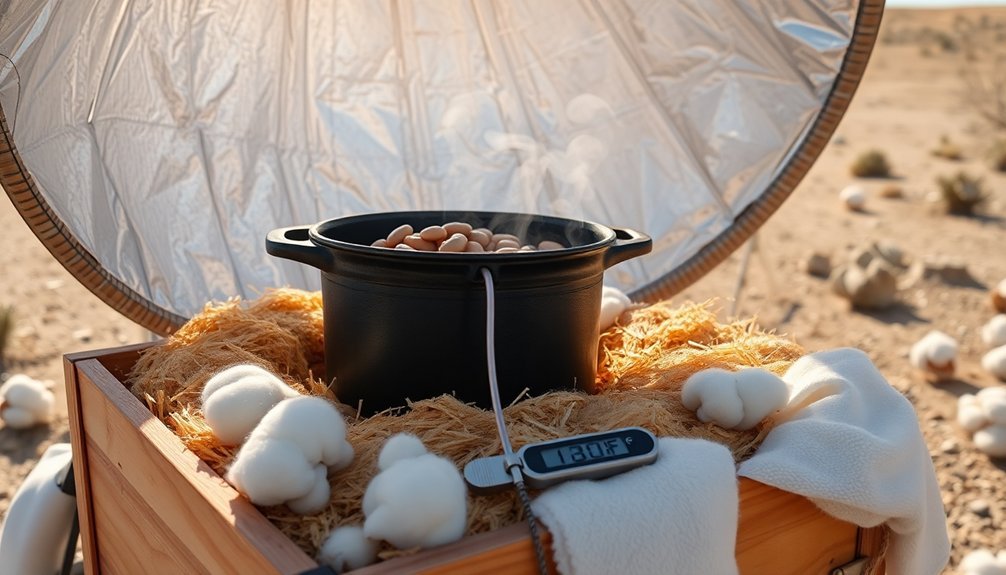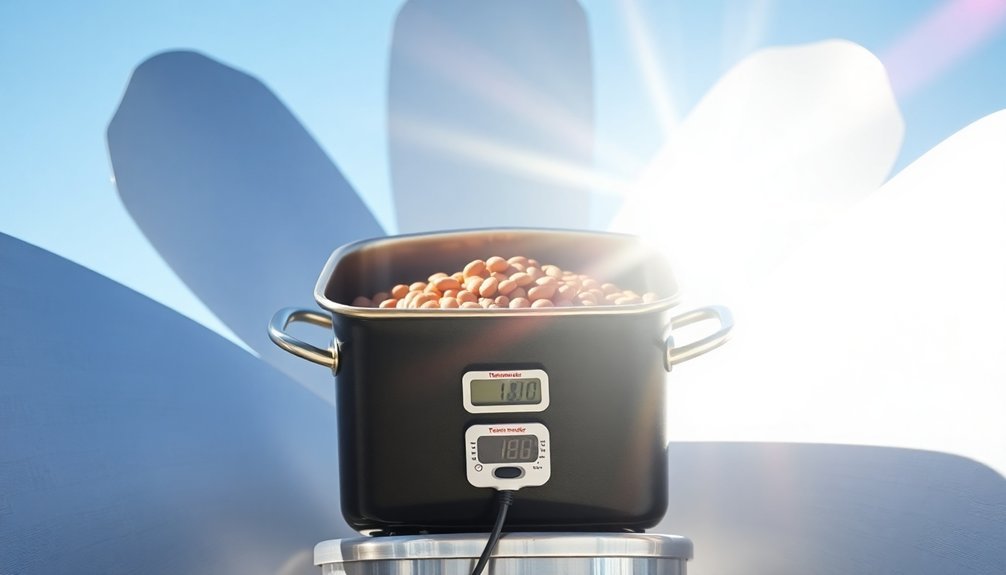To safely solar cook dried beans, you'll need to start by soaking them overnight and rinsing thoroughly to remove debris. You can use five reliable methods: a dark pot cooking system that optimizes heat absorption, a solar box oven with reflective panels, a heat retention storage setup for consistent temperature, a basic solar cooker with adjustable reflectors, or a thermal energy storage system for extended cooking times. Keep temperatures between 180-250°F and adjust your cooker's position to track the sun. Proper preparation and temperature management are essential for perfectly tender beans – and there's much more to explore about maximizing your solar cooking success.
Pre-Soaking and Temperature Control

A successful solar-cooked bean dish starts with proper pre-soaking and temperature management.
You'll want to begin by soaking your dried beans overnight, or if you're short on time, use the quick-soak method by boiling them briefly and letting them sit for an hour at room temperature. This pre-soaking step guarantees even cooking and helps break down the starches that can cause digestive issues.
While thinner-skinned varieties like black beans, pinto beans, and lentils mightn't strictly require soaking, you'll get better texture and digestibility if you do.
When using your solar cooker, you'll need to maintain temperatures between 82-121°C (180-250°F) for ideal results. You'll find that these moderate temperatures are perfect for cooking beans without burning them. Place your beans in a dark colored pot for optimal heat absorption.
Don't forget to monitor and adjust your cooker's position throughout the day to maintain consistent heat. Your cooking times will be similar to stovetop methods, typically taking 1-3 hours depending on the quantity and type of beans you're preparing.
Dark Pot Cooking Method
Dark pots serve as the cornerstone of effective solar bean cooking, transforming sunlight into the steady heat needed for tender results. You'll want to select a thin, dark metal pot with a well-fitting lid, such as Granite Ware, which efficiently absorbs and converts sunlight into heat. If you're using lighter cookware, wrap it in a dark towel to improve heat absorption. Pre-heating for 15 minutes will help your beans cook more evenly.
Place your pre-soaked beans in the dark pot and make certain the lid fits tightly to trap moisture. Position the pot inside your solar cooker's transparent heat trap, which allows sunlight to enter while maintaining consistent temperature.
| Pot Type | Heat Absorption | Best Uses |
|---|---|---|
| Dark Metal | Excellent | All-purpose cooking |
| Granite Ware | Very Good | Beans and stews |
| Painted Dark | Good | Low-temp cooking |
| Modified Light | Fair | With dark covers |
| Reflective | Poor | Not recommended |
You don't need to stir constantly, but you'll want to adjust the cooker's position periodically to track the sun. Remember to use pot holders when checking your beans, as dark surfaces can become extremely hot. For maximum efficiency, angle your reflective panels to concentrate sunlight onto the pot's surface.
Heat Retention Storage System

Thermal energy storage systems revolutionize solar bean cooking by extending your cooking capabilities beyond daylight hours. You'll find these systems integrated with solar cookers, using materials like sunflower oil and erythritol to store heat for up to three days. When you're cooking beans, this stored heat becomes invaluable, allowing you to maintain consistent temperatures even after sunset. The system's vacuum chamber insulation helps maintain optimal cooking temperatures with minimal heat loss.
The heat retention cooking method works perfectly for beans. You'll start by heating your pot in the solar cooker, then transfer it to an insulated container before the temperature drops below boiling. Your beans will continue cooking slowly and safely in this insulated environment, using stored thermal energy.
Key components of an effective heat retention system include:
- Clay-coated carbon bricks that can withstand temperatures up to 300°C
- Aluminum pipe heat exchangers for efficient heat transfer
- Insulating pads or soft cushions to maintain temperature
While the initial investment might be higher than traditional cooking methods, you'll see long-term benefits through reduced fuel costs. Your TES system can pay for itself within 2-3 years, while providing reliable, sustainable cooking capabilities for your dried beans.
Solar Box Oven Setup
Setting up your solar box oven starts with basic household materials that transform into an efficient cooking device. You'll need a cardboard box, clear plastic wrap or plexiglass, aluminum foil, insulation materials, and a cooking rack for proper assembly.
Begin by cutting a three-sided flap in the box's lid and line it with aluminum foil to create a reflective surface.
Next, seal the box opening with clear plastic wrap or attach plexiglass to form a window that lets sunlight in while retaining heat.
Line the bottom with black construction paper and add crumpled newspapers for insulation.
Install a heat-resistant cooking rack to guarantee proper airflow around your food.
For enhanced efficiency, you can use two boxes, placing the smaller one inside the larger one for better insulation. Make sure the inner box is airtight and includes slots for food insertion.
You'll need to monitor the internal temperature, aiming for at least 178°F, and adjust the reflective flap's angle to maximize sunlight exposure.
Remember to reposition your oven periodically to maintain the best sunlight throughout the cooking process.
For optimal cooking performance, use darkened or blackened cookware to effectively absorb and retain heat.
Reflector Panel Bean Cooking

Successful reflector panel bean cooking relies on three essential components: proper panel positioning, pot placement, and sun tracking.
You'll need to position your reflector panels at multiple angles, with the top panel at a steep angle and the bottom panel more shallow to maximize sunlight capture throughout the day. Heat conversion takes place as the black pot absorbs and transforms sunlight into cooking energy.
Place your dark-colored pot in the center of the cooking area, making sure it's covered to retain heat and steam.
For ideal bean cooking results, follow these critical steps:
- Adjust your reflector panels periodically to track the sun's movement, guaranteeing the reflected rays consistently hit your cooking pot.
- Keep your pot securely positioned and covered to maintain steady cooking temperatures.
- Wear protective sunglasses when checking or adjusting your solar cooker.
Remember that the reflector's capture area directly affects your cooking efficiency. You can enhance your setup by eyeballing the angles to guarantee sunlight hits your target area effectively.
When handling your bean pot, always use oven gloves to prevent burns, and monitor the temperature with a thermometer to achieve consistent cooking results.
The combination of proper panel angles, secure pot placement, and regular sun tracking will help you achieve thoroughly cooked beans.
Frequently Asked Questions
Can I Solar Cook Beans During Cloudy Weather or Winter Months?
You can solar cook beans in cloudy weather and winter, but you'll need longer cooking times and good insulation. On partially cloudy days or clear winter days, pre-soak beans and use a well-insulated cooker.
What Should I Do if Animals Are Attracted to the Cooking Smell?
If you notice animals drawn to cooking smells, immediately move your food to a secure location. Change your clothes, store all food items properly, and consider relocating your cooking spot farther from your campsite.
How Can I Prevent Condensation From Dripping Back Into the Beans?
You can tilt your pot slightly, use a lid with a small gap, and place a cloth to catch drips. When needed, briefly open the oven to release moisture or gently wipe condensation with paper towels.
Are Some Bean Varieties Unsuitable or Dangerous for Solar Cooking?
Avoid raw soybeans, as they don't cook well and can foam dangerously. You'll have better success with black beans, kidney beans, chickpeas, and lentils. They're safer and cook more evenly in your solar oven.
Can Bacterial Growth Occur During the Slow Solar Cooking Process?
Yes, you'll risk bacterial growth if your solar oven doesn't maintain temperatures above 140°F. Keep monitoring the temperature throughout cooking, and don't leave food in the danger zone (40-140°F) for over 4 hours.
In Summary
You've now learned five reliable methods to safely cook dried beans using solar power. Whether you're using a dark pot, heat retention system, solar box oven, or reflector panels, remember to pre-soak your beans and monitor temperatures carefully. With proper planning and these techniques, you'll save energy while producing perfectly cooked beans. Don't forget to store leftovers promptly and follow food safety guidelines for best results.





Leave a Reply